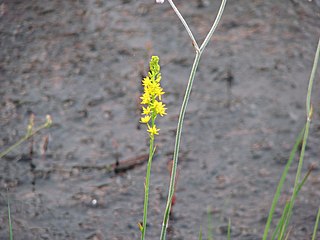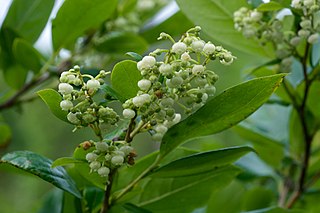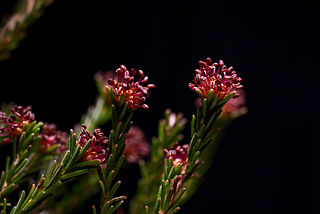
Pioneer species are hardy species which are the first to colonize barren environments or previously biodiverse steady-state ecosystems that have been disrupted, such as by fire. Some lichens grow on rocks without soil, so may be among the first of life forms, and break down the rocks into soil for plants. Since some uncolonized land may have thin, poor quality soils with few nutrients, pioneer species are often hardy plants with adaptations such as long roots, root nodes containing nitrogen-fixing bacteria, and leaves that employ transpiration. Note that they are often photosynthetic plants, as no other source of energy except light energy is often available in the early stages of succession, thus making it less likely for a pioneer species to be non-photosynthetic. The plants that are often pioneer species also tend to be wind-pollinated rather than insect-pollinated, as insects are unlikely to be present in the usually barren conditions in which pioneer species grow; however, pioneer species tend to reproduce asexually altogether, as the extreme or barren conditions present make it more favourable to reproduce asexually in order to increase reproductive success rather than invest energy into sexual reproduction. Pioneer species will die creating plant litter, and break down as "leaf mold" after some time, making new soil for secondary succession, and nutrients for small fish and aquatic plants in adjacent bodies of water.

Ceratiola is a genus of flowering plants with a single species, Ceratiola ericoides, the sand heath, sandhill-rosemary or Florida-rosemary, is a species of shrub usually included in the plant family Ericaceae, though treated by some botanists in the Empetraceae. It is the sole species in the genus Ceratiola.

Xerophyllum asphodeloides is a North American species of flowering plants in the Melanthiaceae known by the common names turkey beard, eastern turkeybeard, beartongue, grass-leaved helonias, and mountain asphodel. It is native to the eastern United States, where it occurs in the southern Appalachian Mountains from Virginia to Alabama, and also in the Pine Barrens of New Jersey.

Narthecium americanum is a species of flowering plant in the Nartheciaceae known by the common names yellow asphodel and bog asphodel. It is native to New Jersey in the United States. It is now apparently limited to that state, having likely been extirpated from Delaware, North Carolina, and South Carolina.

Quercus ilicifolia, commonly known as bear oak or scrub oak, is a small shrubby oak native to the eastern United States and southeastern Canada. Its range extends in the United States from Maine to North Carolina, with reports of a few populations north of the international frontier in Ontario. The name ilicifolia means "holly-leaved."

Vaccinium deliciosum is a species of bilberry known by the common names Cascade bilberry, Cascade blueberry, and blueleaf huckleberry.

Lysimachia asperulifolia is a rare species of flowering plant in the Primulaceae known by the common name rough-leaved loosestrife and roughleaf yellow loosestrife. It is endemic to the Atlantic coastal plain in North Carolina and northern South Carolina in the United States, where there are 64 known populations. It is a federally listed endangered species of the United States.

Rhynchospora knieskernii is a rare species of sedge known by the common name Knieskern's beaksedge. It is endemic to the state of New Jersey in the United States, where it occurs naturallyin the Pine Barrens. Reports have cited it present in Delaware as well, but these populations appear to have been introduced. It is threatened by the destruction and degradation of its habitat. It is a federally listed threatened species of the United States.

Liatris punctata is a species of flowering plant in the aster family known by the common names dotted gayfeather, dotted blazingstar, and narrow-leaved blazingstar. It is native to North America, where it occurs throughout the plains of central Canada, the central United States, and northern Mexico.

Calamagrostis montanensis is a species of grass known by the common names plains reedgrass and prairie reedgrass. It is native to North America, where it is found across Canada from British Columbia to Manitoba and south to Colorado in the United States.

Holodiscus dumosus is a species of flowering plant in the rose family, with the common names mountain spray, rock-spiraea, bush oceanspray, and glandular oceanspray.

Lyonia ligustrina is a species of flowering plant in the family Ericaceae known by the common names maleberry and he-huckleberry. It is native to the eastern United States from Maine to Florida and west to Texas and Oklahoma.

Lyonia lucida is a species of flowering plant in the family Ericaceae known by the common names fetterbush lyonia, hurrahbush, and staggerbush. Other plants may also be called fetterbush. This broadleaved evergreen plant grows on the coastal plain of the southeastern United States from Virginia to Florida to Louisiana. It also occurs in Cuba.

Salix brachycarpa is a species of flowering plant in the willow family known by the common names barren-ground willow, small-fruit willow and shortfruit willow.

Vaccinium myrsinites is a species of flowering plant in the heath family known by the common name shiny blueberry. It is native to the southeastern United States from Alabama, Georgia, South Carolina and Florida. It may occur as far west as Louisiana.

Vaccinium pallidum is a species of flowering plant in the heath family known by the common names hillside blueberry, Blue Ridge blueberry, late lowbush blueberry, and early lowbush blueberry. It is native to central Canada (Ontario) and the central and eastern United States plus the Ozarks of Missouri, Arkansas, southeastern Kansas and eastern Oklahoma.

Carex barrattii is a species of sedge known as Barratt's sedge. It is endemic to the United States, where it occurs on the Atlantic Coastal Plain from Connecticut south to Georgia and Alabama. It also occurs in the southern Appalachians.

Corema conradii is a species of flowering plant in the heath family known by the common name broom crowberry. It is native to eastern North America, where it has a disjunct distribution, occurring intermittently from Nova Scotia to Massachusetts, in the Shawangunk Mountains of New York, and in the Pine Barrens of New Jersey. Studies indicate that the plant might be a hybrid between ancestral populations of Corema album and Ceratiola.

Hudsonia tomentosa is a species of flowering plant in the rockrose family known by the common names woolly beachheather, beach heather, and sand heather. It is native to northeastern North America, including central and eastern Canada and the northeastern United States.

Vaccinium oxycoccos is a species of flowering plant in the heath family. It is known as small cranberry, bog cranberry, swamp cranberry, or, particularly in Britain, just cranberry. It is widespread throughout the cool temperate northern hemisphere, including northern Europe, northern Asia and northern North America.





















